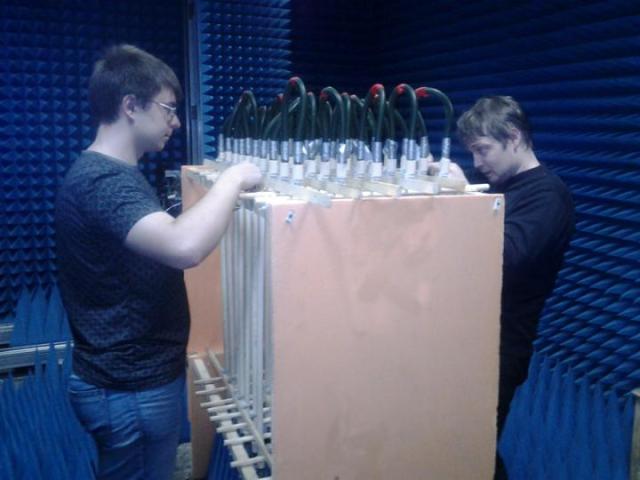Dec 26 2015
A team of physicists from ITMO University, Ioffe Physical-Technical Institute and Australian National University have researched the phenomenon of phase transition between photonic crystals and metamaterials - two types of periodic structures capable of manipulating light in intricate ways. The study helps to gain an insight into the fundamental properties of periodic structures and opens new possibilities for the design and creation of new electromagnetic materials. The results of the study were published in Nature Communications.
 Lattice of plastic pipes filled with heated water was used to test the calculations. Credit: ITMO University
Lattice of plastic pipes filled with heated water was used to test the calculations. Credit: ITMO University
Both photonic crystals and metamaterials are artificial materials compiled of little components with different electromagnetic properties. They resemble actual crystals, although the basic component in these materials is much bigger that just an atom or molecule. In physics, such materials are interesting due to their ability to effectively control the propagation of light. Photons in these materials can move in very unusual trajectories that are defined by the properties of the constituents that make up the periodic structure of the material.
Scientists from Russia and Australia decided to test how the optical properties of such materials would change if their parameters were gradually modified. As a model, the scientists used ? lattice of plastic cylinders filled with heated water.
When interacting with light, such a structure can generate two types of resonances: local Mie resonance, associated with each cylinder individually, and extended Bragg resonance that appears due to the interference of light scattered from all cylinders. If the refraction index of cylinders is high, then the structure is said to belong to metamaterials, while if it is low - to photonic crystals.
The refraction index and the distance between neighboring cylinders are the two main factors that determine the photonic properties of the material.
The researchers made calculations for 100 different values of the refraction index and 50 values of lattice constant - ranging from cases where cylinders touched each other to cases where the distance between the cylinders reached 100 radii of one cylinder.
As a result, 5 000 different photonic structures were investigated. Each was assigned its place in the classification. The interpretation of the data allowed researchers to build the phase diagram of transition from a photonic crystal to a metamaterial.
"Usually, when we talk about phase transition - an abrupt change in material properties - we imagine the conversion of something hard into something liquid or, for instance, the appearance of electric properties caused by changes in temperature or pressure. This is due to the fact that temperature and pressure define the structure of the material at the atomic level. We influence it indirectly, so to speak, just by changing the parameters of the environment," says Mikhail Rybin, first author of the study and senior researcher at the Department of Nanophotonics and Metamaterials of ITMO University and Ioffe Physical-Technical Institute.
"In case of photonic structures, we ourselves define the required properties of the material, choosing the mutual arrangement and refraction index of the structural elements - meta-atoms. This enables us to introduce the concept of phase diagram in sets of axes: geometrical size - refraction index. In our case, the periodic structure generates local negative magnetic response, which acts as a sign of a metamaterial. In other words, the structure converts from a photonic crystal to a metamaterial," adds Rybin.
To test the theoretical calculation, the researchers arranged a meta-crystal out of plastic pipes filled with heated water. The measurements were conducted in the microwave range. In experiments, the phase transition was achieved in two different ways. The first was induced by altering the water temperature in the meta-crystal from 90 to 20 degrees Celsius, which influenced the refraction index of water. The second method consisted in changing the spacing between the pipes, that is, making the meta-crystal smaller. This method resembles the increasing of pressure in conventional phase transitions.
The measurements perfectly matched the theoretical predications, required to build a phase diagram. The work therefore has become the first attempt to imagine photonic crystals and metamaterials within the single system with a set of parameters. This is important, because now researchers do not need special calculations to anticipate which materials should be used to produce structural elements, and how densely they should be packed to produce a metamaterial.